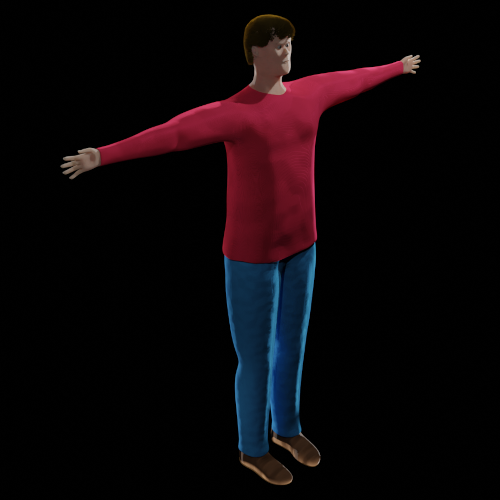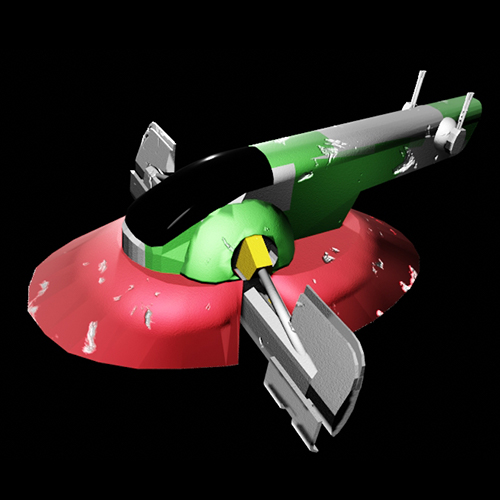Assignment Details
Model a realistic, complex object such as a car, human, animal, or space ship. Your model should be more complex and beyond the Intermediate Modeling assignment. It can be just an extension of your Intermediate Modeling project as well. You should be able to demonstrate multiple intermediate techniques and/or some advanced techniques. Add some realistic materials and textures to your object like those used in the Intermediate Materials and Textures assignment. You may need to add a good lighting system as well in order to see the 3-dimensional depth of your model. You might also explore the particle system in Blender which will get Blender to create complex objects for you such as smoke, fire, trees, or explosions.
Advanced Modeling Topics
Beginner modeling involves learning edit mode, moving mesh vertices, edges, and faces and the basic modeling tools (subdivide, extrude, knife, bevel, loop cut, etc.). Intermediate modeling is about improving your models and speeding up your workflow. Techniques such as modifiers (subdivision surface, mirror, array, etc.) and proportional editing are used in intermediate modeling.
Advanced modeling goes beyond basic modifiers to further improve your modeling skills. Topics include:
- Sculpting. Turn your object into a pile of clay and sculpt the fine details. This is often done after roughing out the model using the beginner and intermediate techniques.
- Precision modeling. Design objects to be physically created through 3D printing or laser cutting. This is often the realm of CAD software, but Blender has its own set of tools for this.
- Skin Modifier: Get Blender to create the mesh and armature of a character from vertex points.
- Advanced meshes
- Curves: Bezier and Nurbs curves are used for create things that are easier to model by a line or curve (mathematically) rather than by mesh points. Things such as ropes and pipes are often created using curves. Curves are also used to define paths in object creation and animation.
- Creating Paths and Curves
- Objects animating on a path
- Ropes
- Surfaces: Like curves, these are objects that are easier to create using lines and curves instead of mesh points.
- Metaballs: Like curves, metaballs are objects mathematically created procedurally in Blender rather than by mesh points. They are often used to simulate fluids and other effects. They also can be merged together like blobs of clay.
- Water and Fluids
- The physics modifiers have a couple of water options.
- Oceans. Generate ocean waves on a plane with the ocean modifier. Ocean Modifier Tutorial by CG Essentials.
- Fluid simulation
- Curves: Bezier and Nurbs curves are used for create things that are easier to model by a line or curve (mathematically) rather than by mesh points. Things such as ropes and pipes are often created using curves. Curves are also used to define paths in object creation and animation.
- Particle systems are used to generate complex visual effects that would normally be very difficult. They create other objects from a single object. They are generally used to create the following types of effects:
- General particle system tutorial
- Smoke, fire, clouds or dust. Fire and smoke tutorial.
- Hair, fur and grass
- How to Make Fur: Blender Guru
- Understanding the Hair Particle System
- Multiple mesh object simulations: crowds, stars or snowflakes. Falling snow tutorial.
- Fixing Normals for hair and other actions.
- Geometry Nodes are new and used to create more complex shapes. Create shapes from geometry nodes instead of modeling, particles and other modifiers.
- Object generators. Get Blender to create objects itself without you having to draw them. Install an add-on that will allow you to create objects and effects such as trees, mountains, ivy, spaceships, nebulas, plating, vehicles, cities, and more. The smaller ones are free, the larger ones will cost money. You can find many of them inside Blender under the Edit – Preferences – AddOns menu.
- Landscape generator add-on build into Blender: A.N.T
- Tree generators:
- Sapling Tree Gen, CG Essentials Tutorial
- Realistic Forest: CG Geek Tutorial: Use a sapling tree as a particle on an A.N.T landscape.
- Previews of other object generators.
- Blender Guru list of add ons. Some free, some not.
- Giant GitHub list of add ons and more.
- Overview of a few generators: windows, nebula, shapes, spaceships, and plating generators. Some are free and some cost money.
- Scene add-on generators: Earth, outer space, and terrain. These are great but cost money.
- HDRI Backgrounds. HDRI backgrounds are used to create full, 3D backgrounds such as stars, deserts, forests, etc. They are a special type of image that can be viewed in 3D. They also provide lighting and reflections.
- Character Creation. Create an entire character, not just a rough model.
- Baking: in order to speed up render times and export certain lighting and materials, you need to bake these aspects into your objects. For example: instead of having a complex, multi-node, procedural generated material that takes forever to render, you bake the material into the object which will create a single, simple material that will render quickly.
- Baking Normals by Blender Guru
- Baking Lighting in Cycles by Blender Guru
- Intro to Baking by Grant Abbitt multi-part series about baking.
- Baking procedural textures to speed render times by Ryan King Artp









